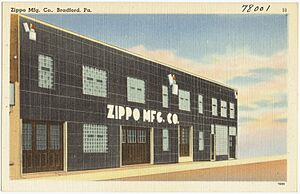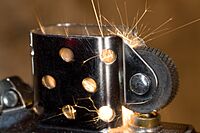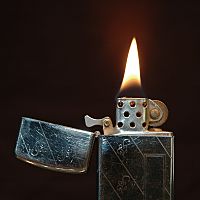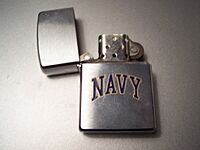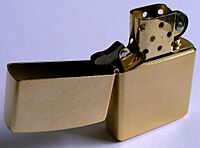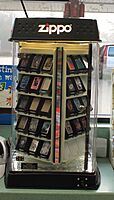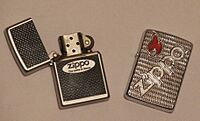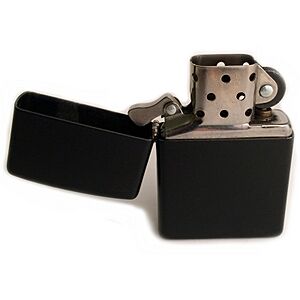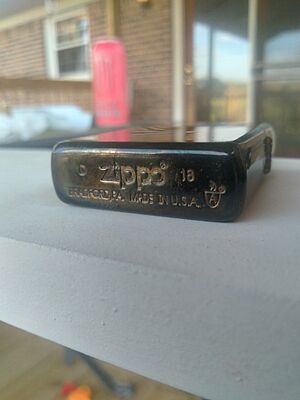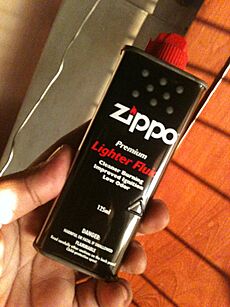Zippo facts for kids
 |
|
| Private | |
| Industry | Manufacturing |
| Founded | 1932 |
| Founder | George Grant Blaisdell |
| Headquarters | Bradford, Pennsylvania, United States |
| Products | Lighters and accessories |
A Zippo lighter is a special metal lighter made by the Zippo Manufacturing Company. This company is located in Bradford, Pennsylvania, United States. Since they first appeared in 1933, thousands of different Zippo styles have been created. They even made special versions for military groups. Zippo lighters are sold all over the world. Many people see them as a famous symbol of America. In 2012, the company made its 500 millionth lighter! Zippo lighters have mostly been made in the United States since 1932. However, they also had a factory in Niagara Falls, Ontario, Canada, from 1949 to 2002.
Contents
The Zippo Story
An American inventor named George G. Blaisdell started the Zippo Manufacturing Company in 1932. He made the very first Zippo lighter in early 1933. He got the idea from a similar lighter made in Austria. Blaisdell liked the sound of the word "zipper". He thought "zippo" sounded even more modern. On March 3, 1936, the U.S. Patent Office gave Zippo a patent for its lighter design.
Zippos in the Military
Zippo lighters became very popular with the United States military. This was especially true during World War II. The Zippo company stopped making lighters for regular people then. Instead, they made them only for the U.S. military. A war reporter named Ernie Pyle even wrote to Zippo's founder. He said Zippo was "probably the most important element on the front." During the war, Zippos were usually made of brass. But because metal was scarce, they used steel with a black finish.
The Zippo company never had an official military contract. However, soldiers often asked for Zippos at their base stores. It was common to see Zippos with military badges or emblems. During the Vietnam War, American soldiers started engraving their Zippos. They would put personal messages on them. These lighters are now very popular with collectors. They are also special souvenirs for people visiting Vietnam.
Zippos After the War
After World War II, Zippo lighters were often used in advertisements. Many companies, big and small, used them through the 1960s. Early Zippo ads were often hand-painted artworks. As technology changed, so did the look of Zippo lighters. But the basic way a Zippo works has stayed the same. They became a popular fashion item, with many artistic designs.
In 2002, Zippo started making other types of lighters. These were called Zippo MPLs, or multi-purpose lighters. In 2005, they released the Outdoor Utility Lighter (OUL). These lighters used butane fuel. In 2007, Zippo launched a new butane lighter called the Zippo BLU. They stopped making the BLU line on January 1, 2016.
The Zippo Museum
There is a museum called the "Zippo/Case Visitors Center" in Bradford, Pennsylvania. It is located at 1932 Zippo Drive. This building is about 15,000 square feet. It holds rare and special Zippo lighters. You can also buy all kinds of Zippo products there. The museum was featured on a radio show in 2009. It also has a huge collection of Case knives. Since Zippo's 60th anniversary in 1992, they have made special lighters each year for collectors.
In 2009, Zippo announced they would buy Ronson Consumer Products Corporation. Ronson had been a competitor in the lighter market for a long time. The deal was completed on February 3, 2010.
In March 2011, Zippo's lighter sales had gone down. They used to sell 18 million lighters a year in the mid-1990s. Recently, it was about 12 million. Also, fewer people were smoking. So, Zippo started offering more products with the Zippo name. These included watches, clothes, and even cologne. This idea was similar to how Victorinox Swiss Army Brands Inc. sells watches, luggage, and fragrances.
On June 5, 2012, the company made its 500,000,000th lighter. They also celebrated their 80th anniversary that year. In 2018, Zippo made the famous "click" sound of its lighter a sound trademark. This means the Zippo click is officially one of the most recognized sounds in the world.
On June 3, 2020, the company made its 600,000,000th lighter.
How Zippos Are Used
Zippo lighters are famous for being "windproof." This means they can stay lit even in bad weather. Their design helps block the wind.
It's hard to blow out a Zippo flame from the side. But if you blow down on the flame from the top, it will go out easily. The right way to put out a Zippo is to close the top lid. This cuts off the oxygen, and the flame goes out. One special thing about Zippos is that they burn with a wick.
Opening the top lid makes a clear "clink" sound. This sound is very famous for Zippo lighters. When you close the lighter, it makes a different but also recognizable "clunk" sound. This noise comes from a small lever inside. It helps keep the lid securely open or closed.
When you buy a new Zippo, it doesn't have fuel. Instructions for how to safely fill it are in the package. Zippo also sells its own brand of lighter fluid.
Zippos in the Vietnam War
During the Vietnam War, Zippo lighters were widely used by American soldiers. They were a common tool for many tasks. Soldiers often carried them as part of their gear. The lighters were known for being reliable in tough conditions.
How Much Do Zippos Cost?
As of March 2022, Zippos usually cost between US$17.95 and US$25,000. The most expensive one is the Armor 18k solid gold model. In 2001, a Zippo from 1933 was bought for $18,000 in Tokyo. In 2002, the company bought a 1933 model for its own collection, valued at $12,000. During Zippo's 75th anniversary in 2007, a nearly new 1933 model sold for $37,000.
All Zippo windproof lighters come with a lifetime guarantee. Their famous saying is: "It works or we fix it free." The company says that in almost 75 years, no one has ever paid for a mechanical repair of a Zippo lighter. This is true no matter how old the lighter is.
Date Codes on Zippos
In mid-1955, Zippo started putting codes on lighters to show the year they were made. They used dots at first. From 1966 to 1973, they used vertical lines. From 1974 to 1981, they used forward slashes.
After July 1986, Zippo started adding a date code that showed the month and year. On the left side of the bottom, there was a letter (A–L). This letter showed the month (A for January, B for February, and so on). On the right side, there was a Roman numeral for the year. It started with II in 1986. But in 2001, Zippo changed this system. They started using regular numbers instead of Roman numerals. So, a Zippo made in August 2004 would have "H 04" stamped on it.
How Zippos Are Made
Zippo lighter cases are usually made of brass. They are shaped like a rectangle with a hinged top. On most Zippo models, the top part is slightly curved.
Inside the case are all the parts that make the lighter work. There's a spring lever that keeps the top closed. There's also the wick, a metal chimney to block wind, a flintwheel, and a flint. All these parts are in a metal box that fits snugly inside the outer case.
The inside of this metal box holds five rayon balls. These are like cotton balls and touch the wick. The bottom of this part is covered by a piece of felt. On modern Zippos, the words "LIFT TO FILL" are printed on this felt. This tells you to lift the felt to add fuel. The fuel, which is a light oil (often called lighter fluid or naphtha), is poured onto the rayon balls. They soak up the fuel.
There's also a tube inside that holds a small, round flint. A spring and a screw keep the flint pushed against the flint-wheel. When you spin this rough wheel against the flint, it makes a spark. This spark lights the fuel in the wick.
All parts of a Zippo lighter can be replaced. It takes 108 steps to make one Zippo lighter!
Zippo BLU Lighters
Zippo released the Zippo BLU in 2007. These were butane torch lighters. Zippo worked hard to make sure they still felt like a Zippo. For example, the lid and a special part called the cam were adjusted. This made sure the lighter still made the famous "Zippo click" sound. It was also one of the few butane lighters to use a flint and a striker wheel. The company also sold the BLU2. This version had a squarer shape and didn't have the fuel gauge on the side.
On January 1, 2016, Zippo stopped making the BLU line of lighters. They sold the BLU trademark to another company. However, Zippo still repairs all Zippo BLU lighters.
Zippo's Other Companies
Besides buying the Ronson brand in the US and Canada in 2010, Zippo owns other companies. These include W. R. Case & Sons Cutlery Co. in Bradford, Pennsylvania. They also own Zippo UK, Ltd. in London, England, and Zippo Fashion Italia in Vicenza, Italy.
See also
 In Spanish: Zippo para niños
In Spanish: Zippo para niños


